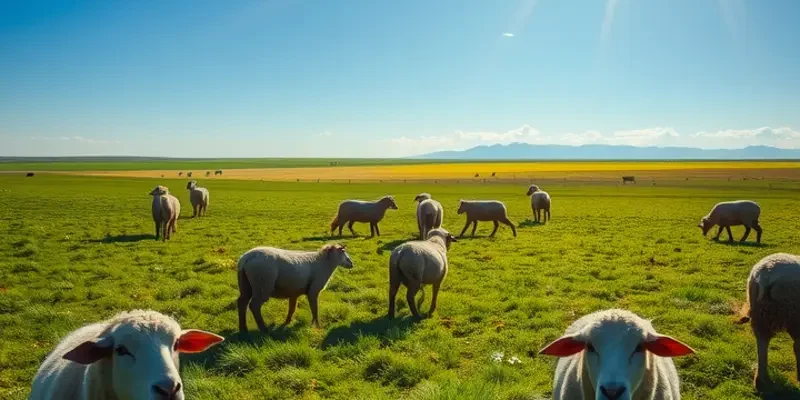Nomadic cultures have traversed vast landscapes, each carrying unique culinary traditions shaped by their environment and lifestyle. These food practices, passed down through generations, embody resilience, resourcefulness, and deep connections to the earth. From the savory stews of Mongolian herders to the aromatic spices of Bedouin cuisine, each dish tells a story of survival and community. Embarking on a culinary journey through these traditions reveals more than just flavors; it uncovers a world of rich heritage and the artistry of cooking in harmony with nature.
Feasting on the Move: The Culinary Art of Mongolian Nomads

Nomadic life in Mongolia is deeply intertwined with the vast, untamed landscape of the steppes. The food traditions that have emerged from this way of life reflect both practical necessities and a strong cultural identity. The centerpiece of Mongolian nomadic cuisine is mutton, a staple that not only offers nourishment but also embodies the pastoral bonds with their herds.
Mutton, along with dairy, forms the backbone of the Mongolian diet. From fermented mare’s milk, known as airag, to a variety of cheeses and curds, dairy products showcase the ingenuity of transforming raw resources into diverse food items. These creations are both a testament to the nomads’ resourcefulness and a link to their pastoral roots.
The methods for preparing meat are as practical as they are flavorful. Take khuushuur, for instance—a hearty hand pie filled with seasoned mutton. Prepared by wrapping meat in dough and frying it until golden brown, khuushuur provides a satisfying meal that is both portable and nourishing, perfect for life on the move. Similarly, buuz, steamed dumplings filled with mutton and fat, offer a comforting warmth against the steppe’s chilling winds. These dishes highlight the Mongolian tradition of using every part of the animal, ensuring nothing goes to waste—a practice resonant with principles of sustainable eating explored further here.
Cooking methods among Mongolian nomads are often dictated by the environment. Utilizing river stones heated in a fire, a dish such as khorkhog is created by placing hot stones inside a pot along with chunks of mutton, water, and vegetables. The hot stones not only cook the food but infuse it with the earthiness of the Mongolian terrain. This method exemplifies the symbiosis between the Mongolian people and their environment.
Meals are more than just an act of consumption; they are a social affair, often shared communally around a ger. The traditional yurt provides a warm, welcoming space where stories are passed down and relationships are strengthened—a reflection of the larger importance of community in nomadic life.
In Mongolian culture, the preparation and sharing of meals are acts that bind individuals to their ancestors and the landscape, highlighting the intricate weave of survival, tradition, and identity. The art of nomadic cooking is not merely about feeding the body—it nurtures the spirit and fosters a deep-seated connection with the land that has supported the nomads for generations. This understanding of food as a central pillar of community and culture offers a unique insight into how cuisine can transcend sustenance and become a reflection of life itself.
A Spice Odyssey: The Culinary Heritage of Bedouin Tribes

The culinary legacy of Bedouin tribes is a captivating journey through time, revealing the deep connections between their way of life and the foods that sustain them. Amid the arid landscapes of the Arabian Desert, Bedouin cuisine stands as a testament to resilience and resourcefulness. Here, spices are not mere ingredients; they are an embodiment of hospitality and tradition, painting rich tapestries of flavor with every dish.
Central to this culinary tradition is the art of the zarb. This slow-cooked medley of meats and vegetables, prepared underground in an earthen oven, captures the essence of Bedouin cooking. The process begins with carefully selected cuts of lamb, goat, or chicken, infused with a blend of aromatic spices. Commonly used spices include cumin, cardamom, coriander, and turmeric, each playing a role in enhancing the dish’s depth and character.
The preparation of zarb is as much a social event as it is a culinary one. Men and women gather to create the feast, showcasing their roles in both culinary arts and community. As the fire pit is dug, each layer is carefully constructed to ensure even cooking. The meat is placed closest to the embers, with vegetables forming protective layers atop, reflecting a wisdom born from generations of practice.
Once the pit is sealed with sand, the meat roasts slowly, absorbing the vibrant flavors of the spices and the smoky earthiness of its natural oven. Hours later, as the zarb is unveiled, the tantalizing aroma of spices intermixed with perfectly tender meat captivates the senses, becoming an irresistible invitation to gather and share.
Aside from the zarb, Bedouin cuisine is enriched with rice dishes, stews, and flatbreads, each tracing the nomadic lifestyle of its creators. Kabsa, a spiced rice dish often featuring raisins and nuts, exemplifies how staple goods are transformed into luxurious feasts. Similarly, fragrant stews like marak utilize available herbs and spices, revealing a sophisticated approach to simple ingredients.
Yet, it is not solely the spices that make Bedouin dishes distinct. The very landscape dictates the ingredients used. The desert provides a backdrop not only of scarcity but also of unique bounty. Date palms offer sweet succor, and wild herbs impart distinctive flavors unlike any found elsewhere.
Through centuries, Bedouin gatherers have adopted innovative techniques to harness the sparse flora of their land. The roasting of indigenous seeds and nuts bring a smoky, nutty essence pivotal to Bedouin gastronomy. Meanwhile, dried lemon, a staple in many Arabian dishes, offers a tangy counterpoint to the warmth of spices, showcasing an expert balance of flavor.
Thus, Bedouin cuisine is a celebration of the earth’s raw simplicity and the complexity of human ingenuity. It echoes the themes of sustainability and adaptation, as seen in other culinary influences through trade, making it a vivid chapter in the larger narrative of global nomadic cuisines. The rhythmic dance of spices and traditions fuse across time, telling stories of survival and unity, waiting to be savored by those who seek to understand this remarkable way of life.
Final words
Exploring the food traditions of nomadic cultures opens up a world of flavors and stories that connect people to their landscapes and histories. These culinary practices not only nourish the body but also reinforce communal bonds, cultural heritage, and resilience in the face of challenges. By embracing these unique food cultures, we gain a deeper appreciation for the artistry of cooking and the profound relationships that form around food. Each dish crafted by nomadic societies is a testament to their journey, reflecting a symbiotic relationship with nature that all food enthusiasts can appreciate and cherish.








